Bioenergy Articles on Biodiesel
Biodiesel and vegetable oil market in European Union: some evidences from threshold cointegration an
INTRODUCTION
Over the last years the growing concern about oil
price rising, fuel security and environmental issue has
increased the policy maker attentions on biofuels
sector. The high level of production raised in EU, 4,9
millions tons of biodiesel produced during 2006 -
equivalent to the 77% of the worldwide biodiesel
production [1] - is strictly related to the political
framework specifically developed in EU.
Among the different policy actions implemented in EU to stimulate the biofuel demand we recall the directive 2003/30/EC, on the promotion of biofuels use, and the subsequent directive 2003/96/EC on energy taxation. While, on the supply side, we remember the non food set-aside and the energy crop premium. The political framework recently implemented in support of biofuels development has had a great impact on production. Since 2005, the first biofuels target year of the directive 2003/30/EC, to 2007, the EU-25 biodiesel production has risen to 57%. In the same period the biodiesel production capacity increased from 4,2 to 10,2 millions tons, equivalent to an increment of 142% [1].
The rapid growth of biofuels production, and foresee for the next future, could have repercussions on the commodity markets used as feedstock and/or bring in action new relationships among food and non food commodities prices. With the aim to gain better insight of price behaviours, we utilized a threshold vector error correction model (TVECM) to investigate if asymmetric dynamic adjusting processes exist between EU vegetable oils prices (rapeseed, sunflowerseed and soybean oil) and fossil diesel price. Among these oils, the rapeseed one represents the major feedstock used for biodiesel production in European Union.
Several studies, in the past, have analysed vegetable oil prices relationships [2], [3], [4], [5], [6] and just recently Yu et al. [7] and Campiche et al. [8] have considered the potential link between vegetable and mineral oil but they used different approach.
THEORETICAL ISSUES
An extensive literature has applied cointegration
techniques to investigate if lung-run equilibrium exists
among prices. These traditional models presume that
the adjustment process to maintain the equilibrium
occur in every time period. Balke and Fomby [9]
introduce the concept of threshold cointegration as a
feasible approach to allow the adjustment process to
move differently in separate regimes. They assume the possibility that a certain threshold discriminates the
movements toward long-run equilibrium. In the case
of two regimes they present a TVECM of order l+1
that takes the form:
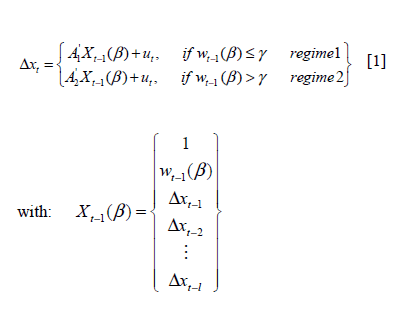
where γ is the threshold parameter, Xt is a pdimensional time series I(1) cointegrated with one px1 cointegrating vector β, wt(β) is the error correction term (ECT), ut is the error term assumed to be iid Gaussian sequence with a finite covariance matrix and finally A1 and A2 are matrices of coefficients describing the dynamics in each regimes. Values of wt-1 below or above the threshold γ allow the coefficients to switch between regime 1 or 2. Testing for the presence of threshold effect is one important statistical issue; Andrews [10], Hansen [11], Balke and Fomby [9] and Lo and Zivot [12] propose different methods. More recently Hansen and Seo [] have contributed further, developing a SupLM test for a given or estimated β using a parametric bootstrap method to calculate p-values, testing the null of linear cointegration versus threshold cointegration.
EMPIRICAL ANALYSIS
We used weekly data from 2005:1 to 2007:11 for
rapeseed oil (RapOil), soybean oil (SoyOil),
sunflowerseed oil (SunOil) and fossil diesel (GasOil).
For the GasOil we utilised Rotterdam diesel prices
collected from the Energy Information Administration
(EIA), while the vegetable oils data were obtained
from Oil World (ISTA Mielke GmbH); all prices are
spot, expressed in US dollars/MT and converted in
natural logarithms. To avoid the seasonality we
transformed data with a monthly adjustments.
Seasonality was investigated with standard F-test (tab.
1); for all variables we rejected the null of no seasonal
patterns.
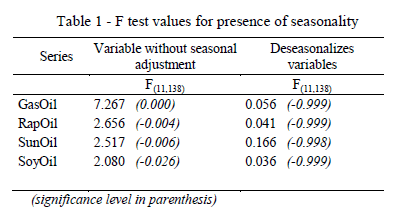
In our analysis we respected the following steps: first we tested the degree of integration of the variables by ADF, PP and KPSS tests. Then we used Johansen approach to evaluate the presence of cointegration between variables and we estimated cointegrating vectors. Finally we tested the presence of threshold cointegration by Hansen and Seo procedure and estimated TVECM.
The results of ADF and PP tests indicates that all the series are I(1) with and without trend (tab.2). KPSS test shows quite different results for GasOil and RapOil with trend and for SunOil without trend, but in any case we can conclude that there are evidences these series are I(1).
We investigated three relationships among the vegetable oils considered and GasOil and we tested the presence of cointegration by Trace and Maximum- Eigenvalue tests. The tests were conducted with intercept in cointegrating equations and with and without linear trend in level data.
The results show that there is one cointegrating vector between RapOil-GasOil price, so they move in tandem in the long run (tab. 3). The SunOil-GasOil and SoyOil-GasOil tests indicate the absence of cointegrating vector, hence these two pair price have very unlikely long-term relationship.
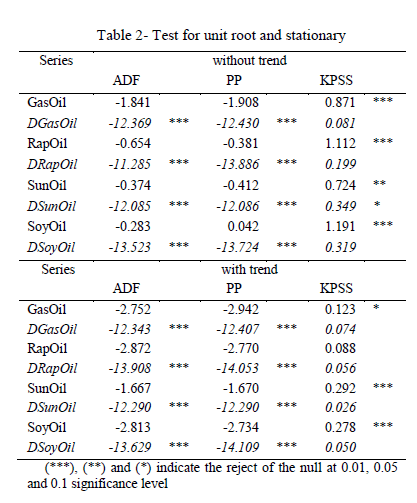
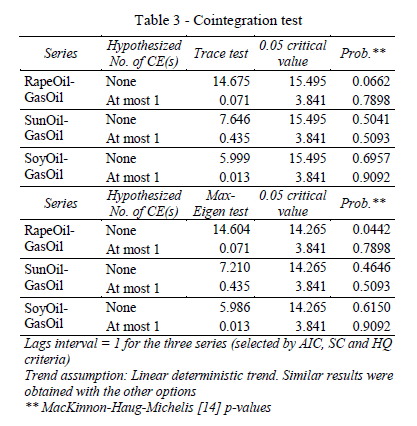
Provided that cointegration evidences are present only in RapOil-GasOil relationship, we estimated a TVECM only for this price pair. The presence of threshold is supported by the application of SupLM test (when β is estimated) using the method proposed by Hansen and Seo: the test supports threshold hypothesis (bootstrap p-value: 0.0388). The estimated cointegrating coefficient is β=-1.53, showing a strong responsiveness of RapOil market to GasOil price movements. The estimated threshold value is γ=-2.91 and identifies two regimes with statistically different ECT at 2% of significances level.
The first regime, or usual regime, occurs when RapOilt-1.53*GasOilt≤-2.91 and includes 82% of the observations, while the second, or unusual regime, includes the remaining 18% of observations and corresponds to RapOilt-1.53*GasOilt>-2.91. The estimated TVECMs are presented below (tstatistics are reported in parentheses considering Eicker-White standard errors):
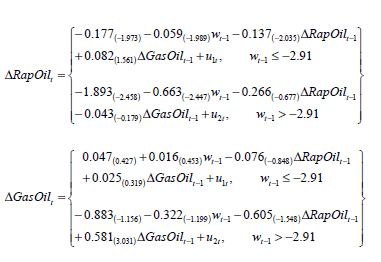
In both usual and unusual regime, the GasOil adjustment parameters are non statistically significative while the RapOil ECTs are significantly different from zero, so we can hypothesize that GasOil price drives RapOil prices toward its equilibrium level. In particular, in the first regime the magnitude of RapOil ECT coefficient (-0.059) indicates a slow adjustment to the long run equilibrium, whereas in the unusual regime the correction is 13 times faster (- 0.663). Therefore the convergence to the long-run equilibrium is not uniform during the overall period analysed, i.e. it is faster when the deviation from the equilibrium exceeds the critical threshold (Fig. 1).
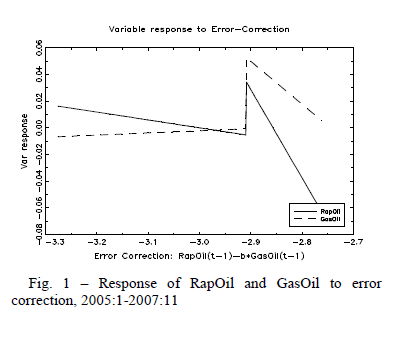
CONCLUSIONS
The main findings of our analysis can be
summarised as follows. First, SunOil and SoyOil
prices are not influenced by fossil fuel, while RapOil
is strong linked to GasOil prices. The long run
relationships between RapOil and GasOil prices
should also be linked to the high quota of EU biodiesel
produced by RapOil (80%).
Secondly, we have demonstrated that asymmetric movements occur between these two prices and that there is evidence of the presence of a threshold defining two different regimes. In extreme situations (18% of observations) GasOil price drives RapeOil price to its long run equilibrium more strongly and faster than in the remaining periods. This non linear relationship could suggest that RapOil is more vulnerable to fossil fuel shocks like it wasn’t in a precedent periods as pointed out by the main results of Yu et al. [7] and Campiche [8]. Therefore, the biofuel political framework recently implemented has activated new relationships between the two markets analysed, making RapOil particularly exposed to global political equilibrium. Hence, it will be advisable that also other vegetable oil (e.g. palm and soy oil) should be more used for EU biodiesel production with the aim to reduce the high prices variability of RapOil deriving from exogenous shocks. Nevertheless the sustainability of the European biodiesel production should pass through the implementation of the regulatory system of sustainable oil seeds production.
by Peri M. and Baldi L. - Department of Agricultural, Food and Environmental Economics, University of Milan

